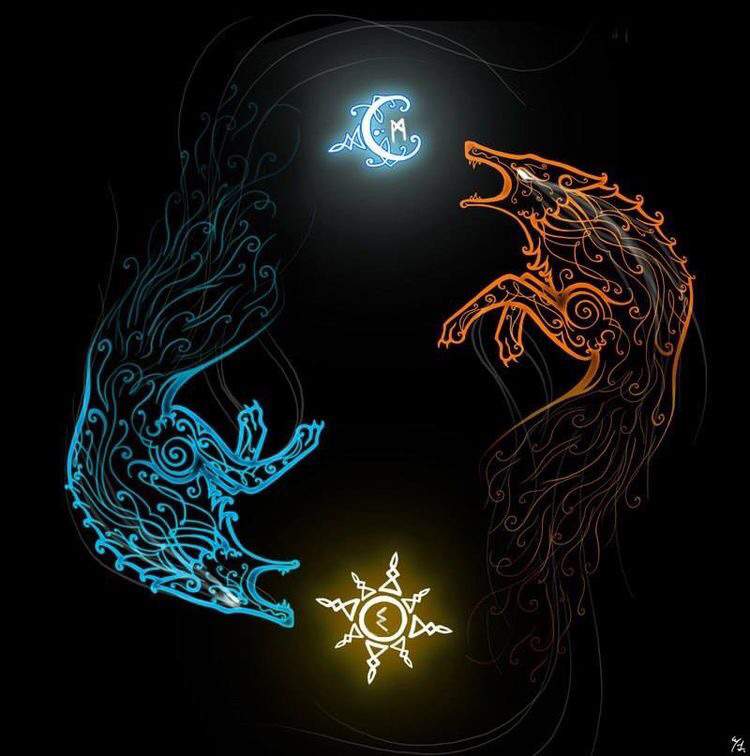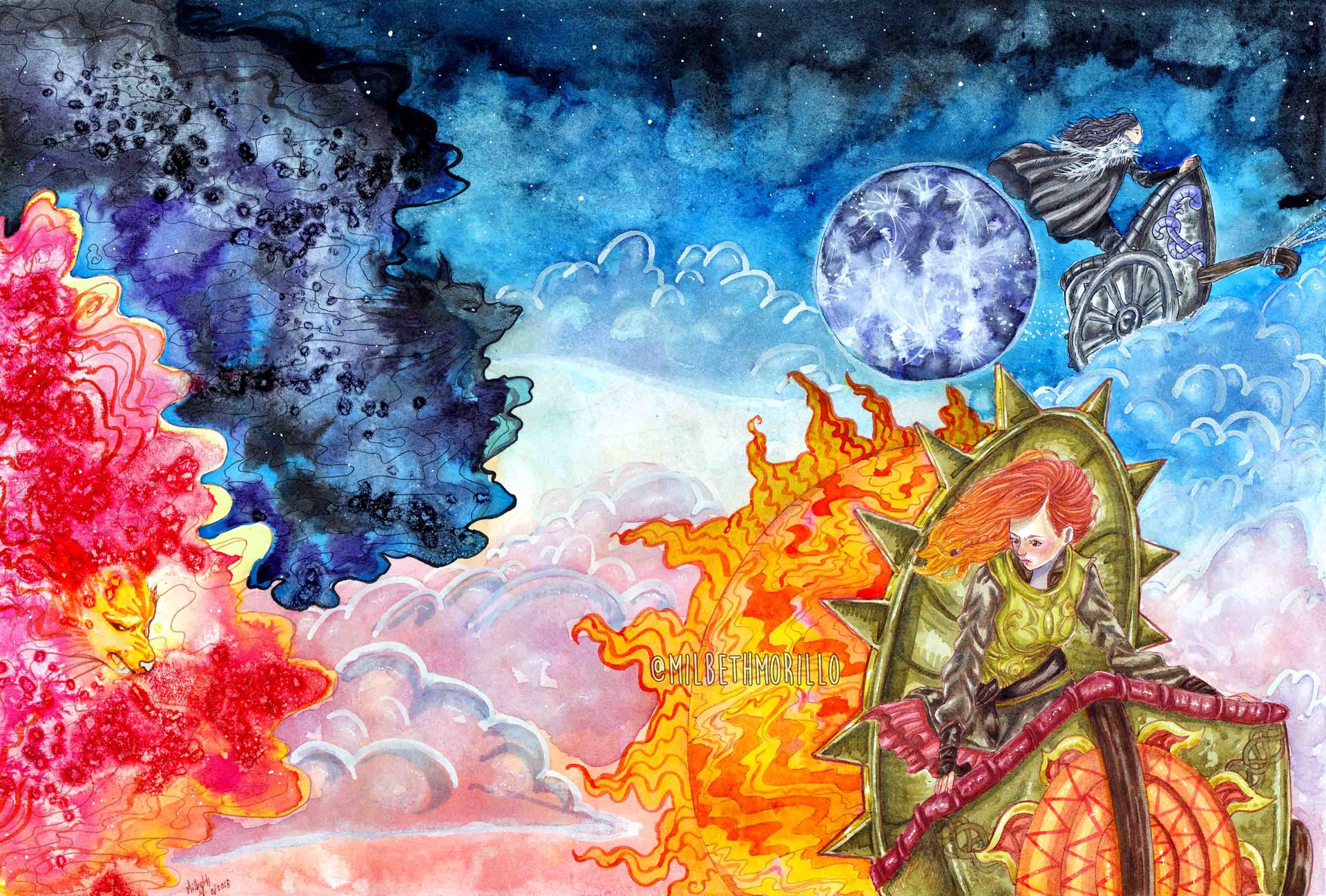Sol and Mani Astrid Jaekel Artist & Illustrator

Tales of Norse Mythology Sol and Mani YouTube
Máni A depiction of Máni and Sól (1895) by Lorenz Frølich. Máni ( Old Norse: [ˈmɑːne]; "Moon" [1]) is the Moon personified in Germanic mythology. Máni, personified, is attested in the Poetic Edda, compiled in the 13th century from earlier traditional sources, and the Prose Edda, written in the 13th century by Snorri Sturluson.

sol and mani (norse gods reimagined) ImaginaryCharacters
In Norse mythology, Sól and Máni were the goddess and god of the sun and moon. Unlike other gods of the sky, however, their trip across the sky was an attempt to escape a pair of hungry monsters! According to the Norse people, each day the goddess Sól drove the chariot of the sun across the sky.

Pin on SÓL y MÁNI, dioses condenados al movimiento astral
In Norse mythology, Sol and Mani were the Sun and Moon, or more precisely, the beings who drove the Sun and Moon in their courses through the sky. Sol and Mani were sister and brother, and both were fair and beautiful.

Sol et Mani Dieux du Soleil & de la Lune dans la Mythologie Nordique
Mani and Sol The chariots were ready, the steeds harnessed and impatient to begin what was to be their daily round, but who should guide them along the right road? The gods looked about them, and their attention was attracted to the two beautiful offspring of the giant Mundilfari.

Sól and Máni Wiki Pagans & Witches Amino
Poetic Edda Prose Edda Frequently Asked Questions Máni Key Facts Name and Etymology In Old Norse, Máni directly translates to "moon," which is pretty straightforward, he is the personification of the moon. Names in Norse mythology often have a deeper meaning or connection to the deity's role or essence, and Máni is no exception.

Sol and Mani Astrid Jaekel Artist & Illustrator
SOL AND MANI "The Wolves Pursuing Sol and Mani" by J.C. Dollman (1909) Sol (pronounced like the English word "soul"; Old Norse Sól, "Sun") and Mani (pronounced "MAH-nee"; Old Norse Máni, "Moon"), are, as their names suggest, the divinities of the sun and the moon, respectively. Sol is female, and Mani male.

Sól and Máni Etsy
Sol and Mani | How Two Children Became Gods Ocean Keltoi 95.8K subscribers Join Subscribe 1.7K Share Save 23K views 1 year ago Patreon: https://www.patreon.com/OceanKeltoi Twitter:.

Norse Myth Sun and Moon BaviPower Blog
Sol among men 'tis called, but with the gods sunna, the dwarfs call it Dvalinn's leika, the Jötuns eyglo, the Alfar fagrahvel, the Æsir's sons alskir. — Thorpe trans. Other kennings for the sun are Daughter of Mundilfari, Sister of the Moon, Wife of Glenr, and Fire of Heaven and of the Air. She and her brother are mentioned in stanza by the.

Sol and Mani Norse gods by ikarunna on DeviantArt
In Norse mythology, Sköll ( Old Norse: Skǫll, "Treachery" [1] or "Mockery" [2]) is a wolf that, according to Snorri Sturluson 's Prose Edda, chases the Sun (personified as a goddess, Sól) riding her chariot across the sky. Hati Hróðvitnisson chases the Moon (personified, as Máni) during the night.

Milbeth Morillo Norse gods and goddesses
Sol and Mani, in old Norse, translates quite literally to the sun and moon. They are known as the beings and Norse deities who drove the Sun and Moon in their courses through the sky. There isn't much known about Sol and Mani, but Snorri Sturluson's account in the Prose Edda offers some insight. How Sol and Mani Came To Be Sol's Fate Mani's Fate

Sol and Mani How Two Children Became Gods YouTube
Sol and Mani "The Wolves Pursuing Sol and Mani" by J.C. Dollman (1909) Sol (pronounced like the English word "soul"; Old Norse Sól, "Sun") and Mani (pronounced "MAH-nee"; Old Norse Máni, "Moon"), are, as their names suggest, the divinities of the sun and the moon, respectively. Sol is female, and Mani male.

Sol and Mani Astrid Jaekel Artist & Illustrator
Today we shall tell a tale about Sol and Mani, and how day and night came to be. Let us know what you think about it and we really hope you all enjoy it!#myt.

Top 19 norse mythology sol and mani en iyi 2022
Together, Sol and Mani voyage across the sky, marking the progression of time and providing light during both the day and the night. The appellation "Sol" originates from the Old Norse term "sól," which straightforwardly translates to "sun."

Sol and Mani A4 Pen Illustration Print Norse Mythology Etsy UK
Mani, the Voyager of the Night Sky: In Norse mythology, Mani is recognized as the embodiment of the moon. Mani is closely associated with Sol, his sister, who is the physical representation of the sun. Together, they traverse the celestial expanse, delivering illumination and darkness to the mortal world. Imagery of Mani often presents him as.

Birth of Life Sol and Maní Gemini art, Visionary art, Occult art
The Sol and Mani were responsible for pulling a chariot across the sky every day and night while simultaneously evading a gruesome death at the hands of wolves. The task was split between the two; Sol operated during the day, and Mani during the night.

Mani is to blame Boudicca's Bard
Sol (pronounced like "soul") and Mani (pronounced like "Mah-nee") were the names of two obscure figures in Norse mythology. Sol was female and Mani was male. In some accounts, they mentioned that Sol and Mani were the children of the Midgard man who was so boastful about his family.